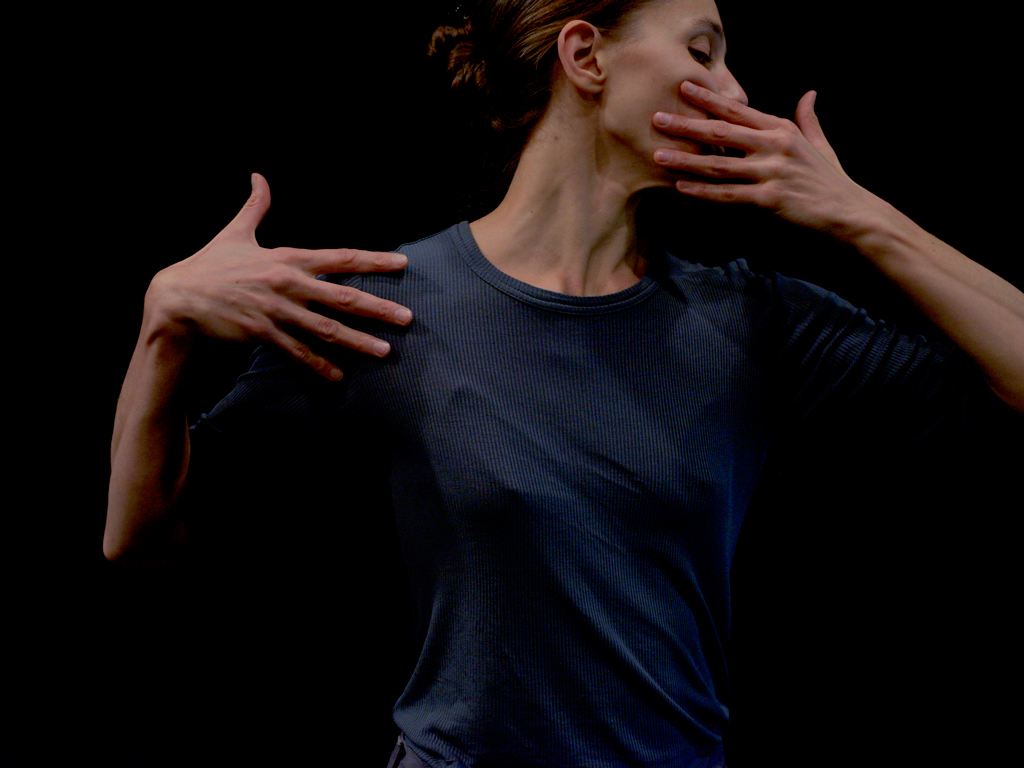Anna Massoni
& Vincent Weber
Retrouvailles inespérées

Residence
May 19 to 23, 2025
CCNR dance studio, Rillieux-la-Pape
As part of Matières Premières
Note of intent
After the pieces Notte and Rideau, two solos, the solo form continues to be explored so that it becomes, beyond a convention, a question and a place for working on multiple arrangements, combinations and articulations that make visible the body’s capacity to produce meaning immediately, as a bearer of memories, figures and narratives. Here, it’s a “solo à deux” or a “double solo” for two sides.
The starting point for this piece is the desire to tell a story. With dance, through dance, alongside dance? Telling a story as a way of illuminating dance, rather than using dance to illustrate the story, is the game of this piece.
Historically, the relationship between dance and storytelling has taken many different forms. Our problem here is how to follow a narrative thread – however tenuous – that doesn’t stifle the gesture’s multiple futures and achievements? How can the time of history and the time of dance coexist? How can a story traverse the performance without enslaving the dance?
By the term story, we're referring in particular to the tradition of almanac stories. These short stories, often subversive or educational, were inserted into popular calendars and peddled in the countryside in the 18th and 19th centuries. Johann Peter Hebel is their most famous exponent. Kafka and Brecht drew inspiration from them in their own stories.
The adaptation of one of Hebel's stories, Retrouvailles inespérées, which brings into play questions of absence, duration, solitude, historical counterpoint, waiting, aging and reunion, is the starting point for this piece. The motif of reversal - specific to these stories, in the form of regular "coups de théâtre" - also becomes a matrix for the dance, which unfolds in a bifrontal space.
Hiding-showing, appearing-disappearing, adding-subtracting: in movement, several tasks are superimposed and articulated in a polyrhythmic way to create paradoxical situations with the body, sometimes abstract and sometimes carrying a narrative, even cinematographic dimension.
In the end, dance and history, combining in a series of successive reversals, produce - in their own way - a relationship with the "unexpected".
— Anna Massoni
Biography
Anna Massoni
Anna Massoni lives and works in Paris. She trained in contemporary dance at the CNSMD in Lyon (2003-2006), took part in Danceweb/Impulstanz (2007) and studied philosophy for three years. As a performer, she has worked with Johanne Saunier and Jim Clayburgh, Yuval Pick, Noé Soulier, Vincent Weber, Simone Truong and Cindy Van Acker. She created the pieces: (To) Come and See (2015), a piece initiated by Simone Truong and turned into a collective creation with Eilit Marom, Elpida Orfanidou and Adina Secretan and developed in 2017 in the form of a triptych including (To) Keep in Touch and (To) Give a Hand. Then Ornement (2016), in collaboration with Vania Vaneau. She creates a first solo, Notte, in 2019, Pièce d'angle, a short piece for both outdoor and indoor spaces (2020), Rideau (2022). She joins forces with Vincent Weber within the same structure that supports their respective work, the Association 33ème parallèle. She is a founding member of LIEUES, a space for artistic and educational research in Lyon, of Rodéo, a multidisciplinary magazine and platform for encounters between academic and artistic practices (2012-2015), and also contributes to the graphic design of books published by Trente-trois morceaux.
Premieres: October 15 + 16 + 17, 2025 at the CND in Pantin, as part of CAMPING
Casting
Concept & choreography: Anna Massoni, Vincent Weber
Performance: Anna Massoni, Vincent Weber
Text: Vincent Weber, d’après J.P.Hebel
Set design & lighting: Angela Massoni
Technical management: Fanny Lacour
Sound research: Renaud Golo
Research: Marc Pérennès, Cynthia Lefebvre
Administration of production: Marc Pérennès
Touring: Marie Fonte
Production: Association 33ème parallèle
Coproduction: CND in Pantin, Chorège-CDCN de Falaise, CCN of Rillieux-la-Pape, ICI/CCN of Montpellier, Le Dancing-CDCN de Dijon, Cndc of Angers, (in progress).
L’association 33ème parallèle is supported by the Ministère de la Culture — DRAC Bourgogne-Franche Comté.
Photos: Anna Massoni, Notte © 33ème parallèle